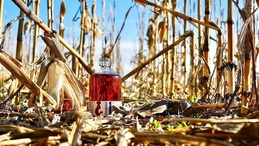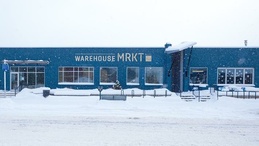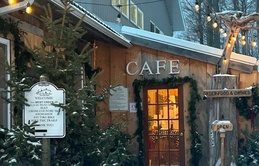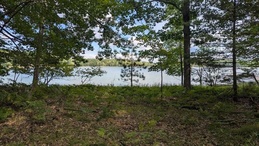
Southern Saviors: Our Chance to Save NoMi Forests?
A local intern's theory has become a regional experiment — and you can take part.
By Craig Manning | March 28, 2020
For years, the Leelanau and Benzie Conservation Districts have been selling bare root seedlings and encouraging locals to plant trees on their properties. This spring, those local organizations are trying something new: a “citizen science” initiative called the Assisted Tree Range Expansion Project, or ATREP.
The project, spearheaded by a former conversation district intern, will encourage locals to plant southern Michigan trees in the northern Michigan habitat. If all goes well, it could go a long way toward shielding northern Michigan forests and wildlife from some of the more detrimental effects of climate change.
BRANCHING OUT
According to Kama Ross, district forester for the Leelanau, Grand Traverse, and Benzie Conservation Districts, climate change has kicked off a domino effect that is already wreaking havoc on northern Michigan forests. The U.S. Forest Service says that changing climate conditions can affect trees by “making them more susceptible to diseases” and by “influencing the spread of infectious diseases and their carriers.” In northern Michigan, diseases such as beech bark disease and oak wilt disease, as well as pests like emerald ash borer, have wiped out huge numbers of beech trees, oak trees, ash trees, and elm trees — to name a few species.
These losses are having impacts that reach far beyond the forests themselves. For instance, oak trees and beech trees, by providing acorns and beech nuts, are key sources of food for squirrels, birds, deer, and other wildlife. Losing these trees, Ross says, is a “making a huge dent in the amount of food that is available for our native wildlife.” Impairment of healthy forestation also risks compromising the region’s ability to handle heavy rainfall, which can lead to runoff and erosion problems elsewhere.
“These losses just change the water systems of our forests, the way the forests sink and hold water and moisture for us,” Ross explained. “We want to make sure that our forests have a wide range of species that can keep this ecosystem healthy and move precipitation. With climate change, you're typically getting more big weather events: big wind events and big water events, rainstorms that erode soil and can't be soaked up by the trees if the forest isn't healthy.”
INTERN INNOVATION
Rather than plant more beech or oak trees — and risk letting those trees be devoured by the same pests and diseases that have devastated the existing populations — ATREP is driven by a different concept: introducing new tree species to the local region.
It’s an idea brought to northern Michigan by Maddy Baroli (pictured above), a recent graduate of the Master of Forest Conservation program at the University of Toronto. A Metro Detroit native with a BA in environmental studies from the University of Michigan, Baroli relocated to Traverse City in 2016 to work with the Groundwork Center for Resilient Communities. Last summer, while interning with Ross at the Leelanau Conservation District, she created an idea that would become not just the capstone project for her master’s degree, but also a potential new beginning for northern Michigan forestry.
“The idea to create ATREP came together slowly throughout my studies and my summer experience with Kama,” Baroli said. “A lot of my studies focused on the effects of climate change and what forest health and management challenges it presents. I got really interested in the concept of assisted range expansion, which is defined as the ‘intentional movement of species to areas just outside their established range in response to climate change, facilitating or mimicking natural range expansion.’
"When the summer rolled around and Kama and I did more and more site visits, it became clear that people were losing lots of trees to disease, severe weather, etc., and that they wanted to respond proactively in order to keep their forests resilient, beautiful, and supportive for wildlife. The puzzle pieces just sort of fell together when I continued pulling at this thread and realized that the Northern Institute of Applied Climate Science (NIACS) actually had published a report which included predictive models that identify tree species which are predicted to gain new suitable habitat in Northern Michigan.”
THE HEAT IS ON
Per NIACS data, Baroli says the temperature throughout the northern Michigan region is predicted to increase by 2 to 8 degrees Fahrenheit over the course of the next century, with warmer weather being particularly likely to hit in the winter and summer months. The area is also likely to see heavier precipitation events going forward. These factors are changing the local ecosystem in many ways. Flowering dates for plants are expected to occur earlier. The growing season, in total, is projected to increase its length by anywhere from 30 to 70 days by the end of the century. The hot summers will lead to drier soils in the late season, which will in turn cause drought stress. The less severe winters will enable greater forest pest survival and bring new pests to the north.
While these changes pose an existential threat to many native northern Michigan tree species, Baroli believes assisted range expansion may hold the answer. The idea of ATREP is to take species of trees that aren’t native to the area — but that are predicted to thrive and reproduce in the changing climate — and to plant them here as a means of diversifying local forests and offsetting recent tree losses.
For Baroli, that means focusing on species that already thrive in southern Michigan and assisting their range expansion into the northern part of the state. This process, she says, is more natural (and much less risky) than migrating trees to the area from farther away.
“Trees do have the capacity to migrate on their own, in response to changes in regional climate patterns,” Baroli said. “However, our fragmented landscape makes it difficult for them to do so. Think of the big agricultural belt in the middle of the state, housing developments, highways, and more. The chances of a bird pooping out seeds in the right spot, or of the wind dispersing a seed to a spot where that tree is even going to have a fighting chance of growing, is increasingly limited.”
THE SUPER SOUTHERN SIX
ATREP, in partnership with the Leelanau and Benzie Conservation Districts, will be helping this process of range expansion along. Using predictions from the aforementioned NIACS report, Baroli handpicked six species of trees that: 1) are native to southern or mid-Michigan; 2) are predicted to thrive in the northern habitat; 3) are not preferred as deer browse or as hosts for the Asian longhorn beetle; and 4) would provide landowners with options to plant in sun or shade, dry or moist areas, and on open or forested land. Most of all, the tree species had to provide “distinct wildlife benefits” to the northern Michigan ecosystem.
The six tree species that are a part of ATREP this year — shagbark hickory, tulip tree, sassafras, black tupelo, hackberry, and swamp white oak — meet all of these criteria. For instance, swamp white oak trees provide acorns for squirrels, beavers, bears, turkeys, and other wildlife, but are immune to the oak wilt disease that has affected many standard oak trees. The tulip tree, meanwhile, is a known larval host to many pollinators.
HOW YOU CAN HELP
As a citizen science project, ATREP needs your help to succeed. The Leelanau and Benzie Conservation Districts are selling seedlings of all six trees between now and April 9, and are seeking private landowners to purchase, plant, and observe the trees over time. Baroli hopes that ATREP will lead to the planting of approximately 1,500 trees this season — and that it will net 25-30 participants to monitor and report back on tree health, growth, survival, and other metrics going forward. In addition to diversifying local forests, ATREP will ideally yield new, valuable research on assisted range expansion. In Michigan, the science so far remains new and lightly researched – though a published study by the University of Michigan showed promising results. Baroli notes that “more experiments are needed” and that ATREP, with the help of locals, can play that role.
Those interested in the ATREP citizen science project can purchase seedlings or learn more by contacting the Leelanau or Benzie Conservation Districts or by visiting the ATREP website at www.atrep.net.
Trending

Farm to Glass with Ethanology
When Elk Rapids distillery Ethanology committed to locally-sourced ingredients for their products, it seemed like they&rsquo… Read More >>
MRKT HLDY SHPPNG, aka Warehouse MRKT Holiday Shopping!
Shop the latest from local makers and vendors at the Holiday MRKT Share at Warehouse MRKT in TC, Saturday, Dec. 20, from 10a… Read More >>
Men and Ugly Sweaters
Those two things don’t always go together, but on Dec. 19, you’ll see both out and about in Petoskey and Harbor … Read More >>


